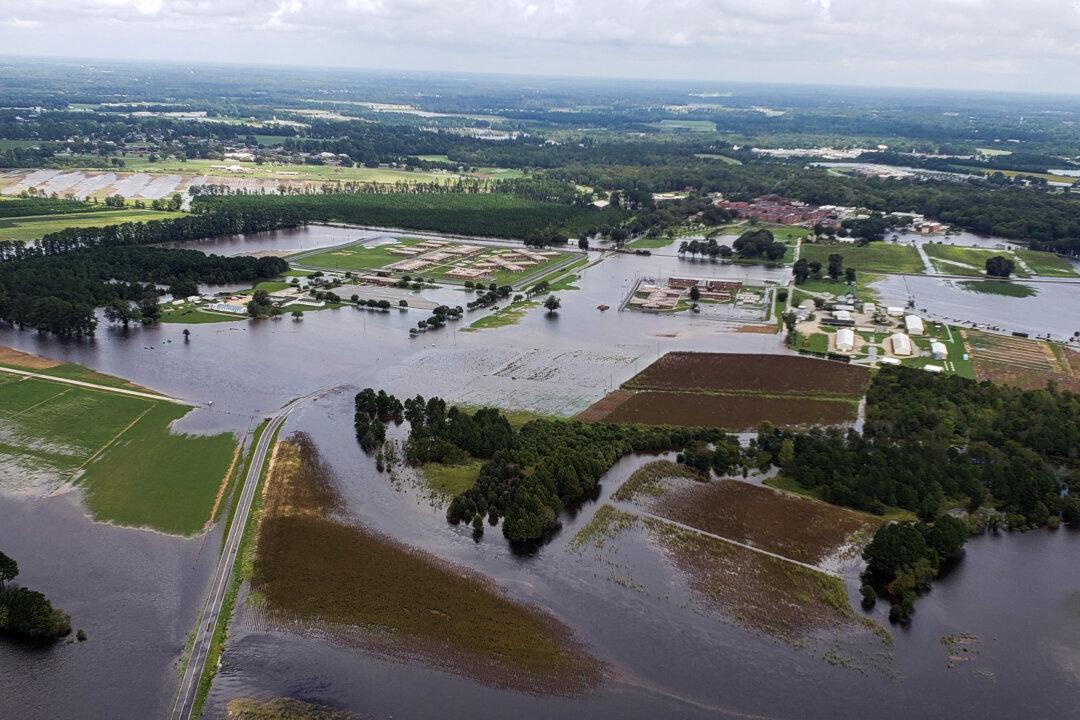There are roughly 9 million pigs in North Carolina––the same number as people. There are also a multitude of poultry farms containing 819 million chickens and 33.5m turkeys and there is even a thriving fish farm industry in North Carolina.
Many thought after Hurricane Matthew in 2016 and Hurricane Floyd in 1999 drowned thousands of hogs and millions of birds, farmers would question the wisdom of situating concentrated animal feeding operations (CAFOs) in flood plains. But apparently not. At least 5,500 hogs drowned during Hurricane Florence and 4.1 million birds, representing 57 farms and 211 poultry houses. In some cases the animal death toll from Florence was double that of previous hurricanes. Video footage shows “hogs wading neck- deep through floodwaters and dead chickens floating like dirty pillows in the dark water,” reported Indy Week.
When the force of Hurricane Florence became known, animal welfare activists pleaded with meat producers to open barn doors to give animals a “fighting chance” to no avail. “No doubt, until their last minutes, they [the animals] did everything possible to keep their heads above water in a relentless struggle to preserve their own lives. They probably cried out in panic for relief that would never come,” wrote one web site.
Legislators are well aware of the results of locating CAFOs sites in floodplains. After Hurricane Floyd, in 1999, the state bought and shut down some hog farmers in low-lying areas. After Hurricane Matthew, Smithfield Foods, a subsidiary of Murphy-Brown, faced millions in nuisance lawsuits from neighbors.
But coverage tends to focus on the toxic effects of manure lagoons spilling into waterways and the economic losses to the North Carolina agriculture industry, not the close to four million animals who farmers left to drown.
Who were these factory farmers? Sanderson Farms admitted to 1.7 chicken lost so far and Butterball said “many of our North Carolina-based processing plants, hatcheries and feed mills have been impacted by the storm, and we continue to see flooding and power outages throughout the region.” But the identities of most CAFOs with thousands of drowned animals are hidden.
“In North Carolina, farm level data is protected information,” Heather Overton, Assistant Director of told me, referring me to the 1979 confidentiality state statute § 106-24.1. which states, “All information published by the Department of Agriculture and Consumer Services pursuant to this Part shall be classified so as to prevent the identification of information received from individual farm operators.”
Such confidentiality laws protect more than the animal toll from Hurricane Florence. They are likely also why the identities of farms with millions of cases of bird flu and porcine epidemic diarrhea virus in recent years were kept secret even as the public continued to buy their products and neighbors and the surrounding environment were jeopardized. Only a handful of photos of bird-flu poultry being “depopulated” and dead piglets dropped into landfills reached the unwitting, deceived public. That is why Overton denied my request to send a photographer to document the disposal of the Hurricane Florence carcasses. (Were they even disposed of or were they sold as “food” some cynics have asked.)
Confidentiality laws are so unyielding, even when an Alabama and Texas ranch produced cows with the always fatal mad cow disease their identities were kept secret and they were allowed to resume operations in 30 days. If anyone questions whether agriculture departments serve the public and consumers or meat producers that’s the answer.
The volume of animals that factory farmers produce and process is so high, the loss of over four million animals during September’s Hurricane Florence is considered nothing but an “animal cycle” and fully insured. It is not consequential to the factory farm industry––nothing to see here–which nonetheless hides the gruesome photos from the public to whom it might be consequential.
In addition to the agricultural cruelty, one must marvel as the sheer stupidity of the North Carolina meat producers. “Haven’t we learned by now that referring to hurricanes as ‘once in a lifetime storms,’ or their impact as ‘100-year floods,’ suggesting that such an occurrence will never happen again is, to be charitable, seriously inaccurate,” writes Dan Murphy in Pork Business.
Martha Rosenberg is author of the award-cited food exposé “Born With a Junk Food Deficiency,” distributed by Random House. A nationally known muckraker, she has lectured at the university and medical school level and appeared on radio and television.





